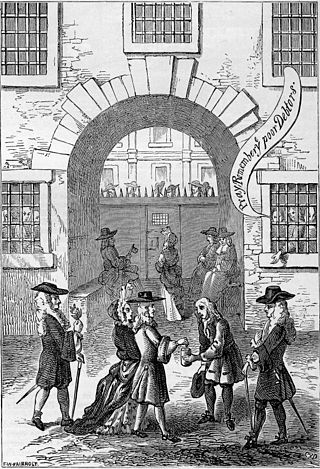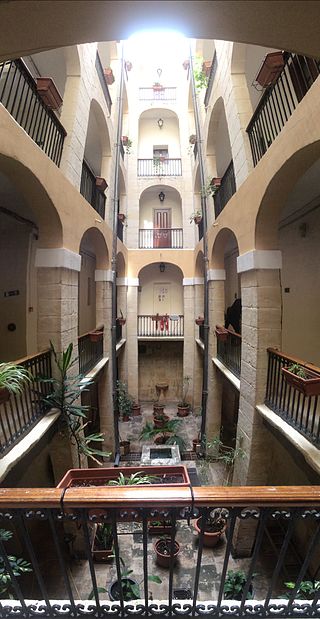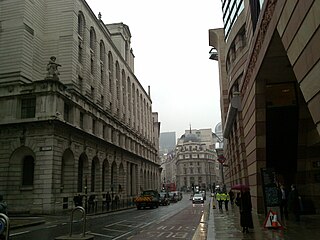
Newgate Prison was a prison at the corner of Newgate Street and Old Bailey Street just inside the City of London, England, originally at the site of Newgate, a gate in the Roman London Wall. Built in the 12th century and demolished in 1904, the prison was extended and rebuilt many times, and remained in use for over 700 years, from 1188 to 1902.

Fleet Prison was a notorious London prison by the side of the River Fleet. The prison was built in 1197, was rebuilt several times, and was in use until 1844. It was demolished in 1846.

A debtors' prison is a prison for people who are unable to pay debt. Until the mid-19th century, debtors' prisons were a common way to deal with unpaid debt in Western Europe. Destitute people who were unable to pay a court-ordered judgment would be incarcerated in these prisons until they had worked off their debt via labour or secured outside funds to pay the balance. The product of their labour went towards both the costs of their incarceration and their accrued debt. Increasing access and lenience throughout the history of bankruptcy law have made prison terms for unaggravated indigence obsolete over most of the world.
Horsemonger Lane Gaol was a prison close to present-day Newington Causeway in Southwark, south London. Built at the end of the 18th century, it was in use until 1878.
William Carter was a Roman Catholic English printer and martyr.

Henry Morse was one of the Catholic Forty Martyrs of England and Wales.

The King's Bench Prison was a prison in Southwark, south London, England, from medieval times until it closed in 1880. It took its name from the King's Bench court of law in which cases of defamation, bankruptcy and other misdemeanours were heard; as such, the prison was often used as a debtor's prison until the practice was abolished in the 1860s. In 1842, it was renamed the Queen's Bench Prison, and became the Southwark Convict Prison in 1872.
A compter, sometimes referred to as a counter, was a type of small English prison controlled by a sheriff. The inmates were usually civil prisoners, for example dissenters and debtors. Examples of compters include London's Wood Street Compter, Poultry Compter, Giltspur Street Compter and Borough Compter and the lock-up over the Abbey Gateway, next to St Laurence's church, in Reading, Berkshire.

The Wood Street Compter was a small prison within the City of London in England. It was primarily a debtors' prison, and also held people accused of such misdemeanours as public drunkenness, although some wealthier prisoners were able to obtain alcohol through bribery. The prison was built and opened in 1555, replacing the earlier Bread Street Compter, from which many prisoners were transferred. Wood Street was closed and replaced by Giltspur Street Compter in 1791.
The Borough Compter was a small compter or prison initially located in Southwark High Street but moved to nearby Tooley Street in 1717, where it stood until demolished until 1855. It took its name from 'The Borough', a historic name for the Southwark area of London on the south side of the River Thames from the City of London. This replaced a lock-up as part of the city's court house under the jurisdiction of the Lord Mayor and Court of Aldermen of the city, and their High-Bailiff of Southwark. This first court house was converted from the old church of the parish St Margaret. A floor was made across the level of the church's gallery and the windows below that were blocked in, the Court Room being on the first floor. This structure was destroyed in the Great Fire of Southwark in 1676.

The Giltspur Street Compter was a compter or small prison, designed by English architect and surveyor George Dance the Younger, mainly used to hold debtors. It was in Giltspur Street, Smithfield, close to Newgate, in the City of London, between 1791 and 1853.

The Marshalsea (1373–1842) was a notorious prison in Southwark, just south of the River Thames. Although it housed a variety of prisoners—including men accused of crimes at sea and political figures charged with sedition—it became known, in particular, for its incarceration of the poorest of London's debtors. Over half the population of England's prisoners in the 18th century were in jail because of debt.

James Neild was an English jeweller and prison reformer. While he was supported by two particular friends, Weeden Butler and John Coakley Lettsom, his efforts were distinct from those of John Howard, and the Quaker group including Elizabeth Fry.

Poultry is a short street in the City of London, which is the historic nucleus and modern financial centre of London. It is an eastern continuation of Cheapside, between Old Jewry and Mansion House Street, towards Bank junction.

The County Gaol, situated in North Parade, Monmouth, Wales, was Monmouthshire's main prison when it was opened in 1790. It served as the county jail of Monmouthshire and criminals or those who fell foul of the authorities were hanged here until the 1850s and some 3,000 people viewed the last hanging. The jail covered an area of about an acre, with a chapel, infirmary, living quarters and a treadmill. It was closed in 1869. In 1884 most of the building was demolished, and today nothing remains but the gatehouse which is a Grade II listed building. Within the gatehouse, there exists "a representation in coloured glass of the complete original buildings". It is one of 24 buildings on the Monmouth Heritage Trail.
The City Marshalsea was a debtor's prison in Dublin, Ireland. Debtors were imprisoned there by order of the Court of Conscience and Lord Mayor's Court of the county of the city of Dublin. The maximum debt was £10 in the Lord Mayor's Court, and 40s. (£2) in the Court of Conscience.

Cork City Gaol is a former prison, now a museum, located in Cork City, Ireland.

Debtors' Prison Relief Act of 1792 was a United States federal statute enacted into law by the first President of the United States George Washington on May 5, 1792. The Act of Congress established penal regulations and restrictions for persons jailed for property debt, tax evasion, and tax resistance. The indebtedness penalty was governed as a forbidding act for citizens indebted to colonial provinces. The public law granted a sunset provision limiting the term of the federal statute for the colonial domains.

Jonathan Strong was an enslaved person and subject of one of the earliest legal cases relating to slavery in Britain and the British abolitionist movement.
















